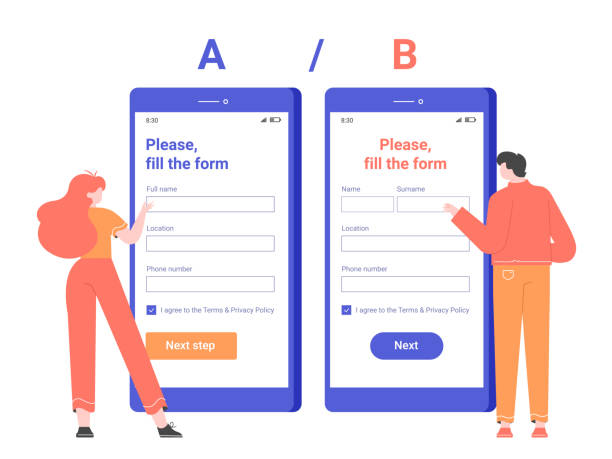An Introduction to the Importance of Secure Website Design in Today’s World

In the current digital age, where every business and individual has an online presence, secure website design is no longer an option, but an undeniable necessity.
Websites act as a storefront and sometimes the entirety of a company, and protecting sensitive user information as well as business data is of paramount importance.
#Cybersecurity, #DataProtection, and #UserTrust are the main pillars of a successful online presence.
An insecure site can not only lead to the loss of customer data but also seriously damage brand reputation and incur heavy legal and financial consequences.
The purpose of this article is to provide a #specialized and #educational comprehensive guide for understanding and implementing the principles of secure website design.
We will show you how you can provide a secure and reliable digital platform for yourself and your users by applying current techniques and standards.
From the importance of security protocols to methods for combating common attacks, all will be examined in this collection.
This proactive approach in secure website design begins from the earliest stages of development and must continue throughout the website’s lifecycle to ensure maximum security.
In fact, web security is an ongoing journey, not a final destination.
Tired of losing business opportunities due to not having a professional corporate website? Worry no more! With Rasaweb’s corporate website design services:
✅ Your brand’s credibility and professionalism will increase.
✅ You will attract more customers and sales leads.
⚡ Get a free consultation right now to get started!
Identifying Common Web Threats and Vulnerabilities

Before we can effectively engage in secure website design, we must familiarize ourselves with the common types of threats and vulnerabilities in the web space.
This understanding is the first step in combating them.
Among the most common attacks are SQL injection, XSS attacks (Cross-Site Scripting), CSRF attacks (Cross-Site Request Forgery), and Denial-of-Service (DDoS) attacks.
Each of these attacks operates in different ways and can lead to unauthorized data access, website destruction, or service disruption.
For example, in SQL injection, attackers inject malicious SQL code into site inputs to gain access to the database.
In XSS attacks, malicious JavaScript code is executed in the victim’s browser, which can lead to the theft of cookies or session information.
This #analytical and #specialized section helps you gain a deeper understanding of the challenges ahead in the path of secure website design and identify appropriate solutions for each threat.
Understanding these vulnerabilities is crucial for any developer and website owner seeking to create a stable and reliable online platform.
This awareness is the foundation of any successful web security strategy and allows you to take necessary precautions and protect your website from dangers before incidents occur.
Furthermore, this section can answer #thought-provoking questions regarding the extent of websites’ vulnerability to cyber attacks.
Best Practices for Coding and Development for Secure Website Design

The foundation of any secure website is proper coding and adherence to best practices in the development process.
This #specialized and #guidance section elaborates on the details developers should pay attention to for ensuring secure website design.
Using secure functions and frameworks, rigorous Input Validation, escaping special characters to prevent code injection, and using parameterized statements in database queries are among these principles.
Furthermore, proper error and exception handling, avoiding the display of verbose error messages that might contain sensitive information for attackers, and using HTTP security headers like Content Security Policy (CSP) and X-Frame-Options are also essential.
Remember that security should be integrated into the Software Development Lifecycle (SDLC) from the beginning, not considered an add-on after development is complete.
This approach means thinking about security at every stage, from initial design to deployment and maintenance.
Implementing these practices significantly reduces your website’s vulnerability and helps maintain website security.
| Vulnerability Type | Description | Prevention Method |
|---|---|---|
| SQL Injection | Injecting malicious SQL code for unauthorized database access. | Using Prepared Statements and parameterizing queries. User input validation. |
| XSS (Cross-Site Scripting) | Injecting malicious client-side scripts to steal information or perform unauthorized actions. | Output Encoding/Escaping and using CSP. |
| CSRF (Cross-Site Request Forgery) | Tricking users into sending unauthorized requests to the website. | Using CSRF tokens in forms. Checking the Referer header. |
| Broken Authentication and Session Management | Weaknesses in authentication and session management mechanisms. | Using secure protocols (HTTPS), proper cookie management, session expiration timing. |
The Role of SSL/TLS Certificates and Secure Hosting in Websites

One of the main pillars of secure website design is the use of encrypted protocols such as SSL/TLS.
SSL/TLS certificates ensure that the communication between the user’s browser and the website server is encrypted, preventing any eavesdropping or data tampering along the way.
This is not only vital for protecting the privacy and security of sensitive user information like passwords and banking details, but it also positively impacts your site’s SEO ranking, as search engines prioritize HTTPS websites.
Choosing a #SecureHosting provider is equally important.
A reputable hosting provider should offer strong security measures such as hardware and software firewalls, Intrusion Detection and Prevention Systems (IDS/IPS), regular data backups, and 24/7 server monitoring.
This #explanatory section on infrastructure demonstrates how a secure hosting environment can act as an additional defense layer for secure website design.
Additionally, regular updates of the server operating system and software used in hosting are essential for maintaining security and preventing known vulnerabilities.
This section is #educational regarding the importance of security infrastructures for websites.
Losing potential customers due to an unprofessional website? Rasaweb is your answer! With our specialized corporate website design services:
✅ Enhance your business’s credibility and standing
✅ Experience attracting more targeted customers
⚡ Act now to get a free consultation!
The Importance of Regular Security Audits and Penetration Testing

To ensure that your secure website design remains continuously effective, conducting regular security audits and Penetration Testing is crucial.
These processes help identify vulnerabilities that may have emerged over time or with changes in the website’s code.
A security audit involves a thorough examination of the code, server configuration, and security protocols to find weaknesses.
Penetration testing, however, goes a step further; in this method, security experts, using real attacker techniques, attempt to penetrate your system to find security flaws before actual attackers discover them.
This #analytical and #specialized approach gives you a realistic view of your website’s readiness against attacks and allows you to fix weaknesses before a disaster occurs.
A question that arises here is: “Is your website sufficiently resilient against cyber attacks?” This #thought-provoking content section provides a practical answer through the implementation of security tests.
The results of these tests can guide you for continuous improvement of website security measures and ensure that your website is resilient against new threats as well.
A regular program for these tests should be an integral part of your secure website design strategy.
The Importance of Security Updates and Patch Management

One of the simplest yet most crucial measures for maintaining secure website design is keeping all software, frameworks, Content Management Systems (CMS), and plugins used up-to-date.
Attackers constantly search for known vulnerabilities in older software versions.
When a vulnerability is discovered, developers quickly release security patches.
Ignoring these updates means leaving the doors open for attackers.
This #informative and #explanatory section emphasizes the importance of being proactive in tracking security advisories and applying patches immediately.
For instance, if you use WordPress, you must ensure that the WordPress core, themes, and all plugins are always updated to the latest stable and secure version.
This also includes the server operating system, database, and programming language.
A regular program for patch management and updates should be part of your website maintenance routine.
Many successful cyber attacks occur due to the failure to apply simple updates.
This issue is a significant and fundamental aspect of the continuous process of secure web development.
By keeping software updated, you are protected against a large portion of known threats, and this alone is a major step towards secure website design.
Do not forget that information leaks or attacks on your website can have irreparable consequences.
Implementing Strong Authentication and Authorization Mechanisms

One of the most important aspects of secure website design is ensuring strong and reliable Authentication and Authorization.
This means you must verify that users are indeed who they claim to be (authentication) and also ensure they only have access to resources they are authorized to access (authorization).
Using strong and unique passwords, implementing two-factor authentication (2FA) or multi-factor authentication (MFA), and storing passwords as hashed values (using strong algorithms like bcrypt) instead of plain text, are among the necessities.
Additionally, mechanisms for account lockout after multiple failed login attempts, as well as encrypting communications via HTTPS, should be considered.
In the authorization section, roles and access levels must be precisely defined, and the Principle of Least Privilege should be observed, meaning users only require the minimum access necessary to perform their tasks.
This #guidance and #specialized approach significantly helps protect your website’s user accounts and sensitive data.
These measures are vital for secure website design and can make the difference between a successful attack and a protected website.
| Mechanism | Description | Security Benefits |
|---|---|---|
| Strong Passwords | Requiring the use of a combination of uppercase and lowercase letters, numbers, and symbols; reasonable minimum length. | Reduces the risk of Brute-Force and Password Guessing attacks. |
| Two-Factor Authentication (2FA/MFA) | Requires a second factor (such as an SMS code, authenticator app) in addition to the password. | Significantly increases security even if the password is compromised. |
| Password Hashing | Storing passwords as hashed values (e.g., with bcrypt) instead of plain text in the database. | Protects user passwords in case of a database breach. |
| Secure Session Management | Using secure session tokens, regular session expiration, and token regeneration after password change. | Prevents session hijacking attacks. |
| Principle of Least Privilege (PoLP) | Granting the minimum level of access to users and processes to perform their tasks. | Limits the scope of damage in case of a user account or system compromise. |
Data Encryption and User Privacy Compliance

Alongside communication security and authentication, data encryption and user privacy compliance are fundamental pillars of secure website design.
Data, whether in transit or at rest, must be protected.
Data encryption in the database, especially for sensitive information such as personal, financial, or medical data, is of high importance.
This prevents unauthorized access to information even in the event of a database breach.
In addition to encryption, adhering to privacy principles like GDPR in Europe or other similar regulations in other regions, is vital.
These regulations require websites to be transparent in the collection, use, and storage of user data and give users the right to control their information.
This #engaging yet #explanatory section shows you how respecting user privacy can help build trust and loyalty and ultimately lead to your business’s success.
A website that prioritizes user privacy is not only legally safe but also enhances its credibility and value in the eyes of users.
This is a key aspect of secure web development that should not be overlooked.
Are you lagging behind large online stores in competition?
Rasaweb, with professional e-commerce website design, brings your business online and increases your market share!
✅ Enhance brand credibility and customer trust
✅ Easy shopping experience leads to more sales
⚡ Take action now for a free website design consultation!
Planning for Incident Response and Disaster Recovery

No secure website design is 100% impenetrable on its own.
Even the best security systems may eventually be breached.
Therefore, having a comprehensive plan for Incident Response and Disaster Recovery is of paramount importance.
These plans help you react quickly and efficiently in the event of a cyber attack or any system failure, minimizing damages.
An incident response plan should include phases of identification, containment, eradication, recovery, and post-incident review.
The responsible team, communication channels, and necessary tools should be identified in advance.
A disaster recovery plan should also include strategies for regular data backups, secure storage of backups, and methods for rapid system and data recovery.
This #analytical and #specialized section teaches you how to prepare for worst-case scenarios and ensure your business can withstand major disruptions.
This preparedness not only helps maintain website functionality but also strengthens UserTrust, as they know their information is protected even in emergency situations.
This section completes the secure website design.
The Future of Web Security and Final Recommendations for a Secure Website

The future of web security is constantly evolving with technological advancements and increasing complexity of threats.
Secure website design requires a dynamic and continuous approach that evolves with new threats.
Topics such as Artificial Intelligence (AI) and Machine Learning (ML) are playing an increasing role in detecting and preventing cyber attacks, both for defense and offense.
Blockchain and cloud computing also create new challenges and opportunities for web security.
This #guidance and #educational section helps you look to the future and acquire the necessary readiness to face upcoming security challenges.
Final recommendations for maintaining a secure website include: continuous training for the development team, using security automation tools, continuous monitoring of website logs and traffic, and collaborating with cybersecurity experts.
Every website, regardless of its size, is a potential target for attackers.
Therefore, a proactive approach and commitment to best practices in secure website design not only protect your digital assets but also help create a safer online ecosystem for everyone.
Remember that web security is an unending process and requires continuous attention and updates to ensure your website remains protected against threats.
With these measures, you can achieve a secure website design that benefits both your business and your users.
Frequently Asked Questions
| No. | Question | Answer |
|---|---|---|
| 1 | What does secure website design mean? | Secure website design refers to a set of measures and methods used to protect a website against cyber attacks, unauthorized access, data breaches, and other security threats. Its goal is to maintain the confidentiality, integrity, and availability of information. |
| 2 | Why is website security important? | Website security is crucial for maintaining user trust, protecting sensitive information (such as personal and financial data), preventing financial losses, preserving brand reputation, and complying with legal regulations (such as GDPR). A security breach can lead to customer loss and heavy penalties. |
| 3 | What are some of the most common security attacks against websites? | Common attacks include SQL Injection, XSS (Cross-Site Scripting), CSRF (Cross-Site Request Forgery), Brute Force, DDoS attacks, Broken Authentication, and Missing Function Level Access Control. |
| 4 | What is the role of an SSL/TLS certificate in website security? | An SSL/TLS certificate (which leads to an HTTPS address) is used to encrypt data exchanged between the user and the website server. This prevents eavesdropping or tampering with sensitive information such as passwords and credit card details during transmission and verifies the website’s authenticity. |
| 5 | How can SQL Injection attacks be prevented? | To prevent SQL Injection, one should use Prepared Statements or ORM (Object-Relational Mapping) with validated parameters. Additionally, thorough filtering and validation of user inputs (Input Validation) and applying the principle of least privilege in the database are essential. |
| 6 | What is the HTTP Strict Transport Security (HSTS) protocol and how does it help with security? | HSTS is a web security policy that tells browsers to load the website only over an HTTPS connection, even if the user enters the address with HTTP. This prevents Downgrade attacks and cookie hijacking on public Wi-Fi networks. |
| 7 | What is the importance of regularly updating software and plugins for website security? | Regularly updating the Content Management System (CMS), plugins, themes, and other software components of the site is crucial for addressing discovered security vulnerabilities. Developers constantly release security patches, and failing to update can leave the site vulnerable to known attacks. |
| 8 | What measures can be taken to increase the security of the website’s administrative section (admin panel)? | Changing the default admin panel path, using strong passwords and two-factor authentication (2FA), restricting access to specific IPs, using CAPTCHA on login pages, monitoring logs, and continuous CMS updates are among these measures. |
| 9 | Why is input validation important? | Filtering and validating inputs helps prevent the injection of malicious code or unauthorized data through forms, URLs, or other user input sections. This prevents attacks like XSS and SQL Injection that exploit invalid inputs. |
| 10 | Name a few common tools or services for checking and enhancing website security. | Tools such as Web Application Firewalls (WAF), vulnerability scanners (e.g., Acunetix, Nessus), Intrusion Detection and Prevention Systems (IDS/IPS), CDN services with security features (e.g., Cloudflare), and periodic Penetration Testing can enhance website security. |
And other services of Rasaweb Advertising Agency in the field of advertising
Smart UI/UX: Professional optimization for increased sales using marketing automation.
Smart Customer Journey Map: An innovative platform for improving customer behavior analysis with SEO-driven content strategy.
Smart Sales Automation: An effective tool for increasing sales by customizing user experience.
Smart UI/UX: Designed for businesses seeking digital branding through key page optimization.
Smart Digital Branding: A specialized service for increasing customer acquisition based on precise audience targeting.
And over hundreds of other services in the field of internet advertising, advertising consultation, and organizational solutions.
Internet Advertising | Advertising Strategy | Advertorial
Resources
- Web Security Training – Faradars
- Website Security Checklist – Iran Host
- Comprehensive Website Security Guide – Mizbanfa
- Web Site Security – Net Negar
? With Rasaweb Afarin, transform your business in the digital world. By providing comprehensive digital marketing services, including custom website design, we help you shine in today’s competitive market and achieve your goals.
📍 Tehran, Mirdamad Street, next to Bank Markazi, Kazeroun Jonoubi Alley, Ramin Alley, No. 6

